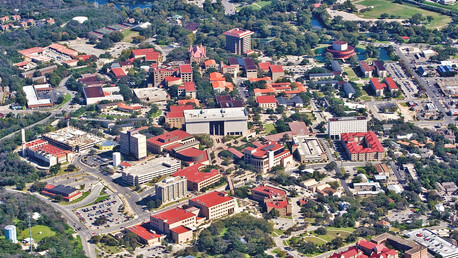Tuition, Cost & Aid
Affordability and Cost
Average Net Price Average net price for full-time, first-time degree/certificate-seeking undergraduates paying the in-state or in-district tuition rate who were awarded grant or scholarship aid from federal, state or local governments, or the institution. Other sources of grant aid are excluded. Aid awarded anytime during the full aid year is included.
Average net price is generated by subtracting the average amount of federal, state or local government, or institutional grant and scholarship aid from the total cost of attendance. Total cost of attendance is the sum of published tuition and required fees (lower of in-district or in-state), books and supplies and the weighted average room and board and other expenses.
Average net price is generated by subtracting the average amount of federal, state or local government, or institutional grant and scholarship aid from the total cost of attendance. Total cost of attendance is the sum of published tuition and required fees (lower of in-district or in-state), books and supplies and the weighted average room and board and other expenses.
$8,692
Average Net Price By Family Income
Tuition
| In-State Tuition In-state tuition is the tuition charged by institutions to those students who meet the state's or institution's residency requirements. In-district tuition is the tuition charged by the institution to those students residing in the locality in which they attend school and may be a lower rate than in-state tuition if offered by the institution. | $3,456 |
| Out-of-State Tuition Out-of-state tuition is the tuition charged by institutions to those students who do not meet the state's or institution's residency requirements. Out-of-district tuition is the tuition charged by the institution to those students not residing in the locality in which they attend school. | $5,352 |
Additional Costs
| Books and Supplies | $1,460 |
| Tuition Payment Plan | Yes |
Financial Aid: visit page
Financial Aid Email: information@sjcd.edu
Aid & Grants
0
100
30%
Need Met
Students Receiving Gift Aid Percent of undergraduate students awarded federal gift aid. Federal gift aid includes any grant or scholarship aid awarded, from the federal government, a state or local government, the institution, and other sources known by the institution. Students Receiving Grants Percent of undergraduate students awarded grant aid. Grant aid includes any grant or scholarship aid awarded, from the federal government, a state or local government, the institution, and other sources known by the institution. Students receiving state aid Students receiving federal aid
29%
Average Aid Per Year
$5,548
29%
Average Federal Grant Aid Per Year
$5,082
Average Institution Grant Aid Per Year
$2,422
28%
Average State Grant Aid Per Year
$1,494
66%
Average Federal Grant Aid Per Year
$5,082
Total Needs Based Scholarships/Grants Total amount of grant or scholarship aid awarded to all undergraduates from the federal government, state/local government, the institution, and other sources known to the institution.
$43,964,452
Total Non-Need-Based Scholarships/Grants
$618,973
Student Loans
Students Borrowing Loans Loans to students - Any monies that must be repaid to the lending institution for which the student is the designated borrower. Includes all Title IV subsidized and unsubsidized loans and all institutionally- and privately-sponsored loans. Does not include PLUS and other loans made directly to parents.
2%
Average Loan Amount Per Year
$3,574
Students receiving federal loans
2%
Average Federal Loans Per Year
$3,574
Average Other Loans Per Year
$10,258
Average Debt at Graduation The median federal debt of undergraduate borrowers who graduated. This figure includes only federal loans; it excludes private student loans and Parent PLUS loans.
$6,250
Loan Default Rate
9%
US National: 7%
Median Monthly Loan Payment The median monthly loan payment for student borrowers who completed, if it were repaid over 10 years at a 5.05% interest rate.
$91
What Students Are Saying
Community college I thought would be more of a bad thing, but with the economy as it is, I think everyone should go to one. The cost of my tuition (out of district) when I was enrolled in 5 classes last semester was about $1,180!!! That's wonderful for me! Especially since the teachers are focused much more on their students than on their salary; this and smaller class sizes can also help you learn more than a bigger school.
Elisa from Houston, TX
It;s cheaper to take the basics at a two year school than a university.
Aurelia from Pearland, TX
This is where San Jacinto excells most. The education there is worth more than you are charged at the business office! Attending this school is a bargain, and you can rest assured that you will get good professors and classmates. Definitely the perfect place for anyone looking to get an associates' degree or just transfer to a 4-year college; and your money will be well spent towards a great education.
Jennifer
When I graduated high school I applied to several universities. A semester at Texas Tech would have totaled near $20,000! My first semester I took 17 hours at San Jacinto Community College and paid a total of $1300! Bang for the buck is an accurate description.
Ivan from Friendswood, TX
I have been able to get a thorough education for under $1,200 per semester, and I have experienced a rigorous college life on a more manageable level for a freshman in college.
Samantha from Seabrook, TX
Definitely great on price! I see no point in attending a more expensive higher education school if the money isn't there to spend when attending a community college, especially this one, is so much easier and cheaper, and the credits transfer to other local colleges. Not to mention, I only live about 15-30 minutes away based on traffic. I find it very reasonable in pricing.
Casey from Pasadena, TX
Mama mia's has a great student lunch special. Also if for any reason you go to Sally's or Dunken Donuts show them your school ID and they'll give you some discount
Anonymous
My tuition and fees for out-of-district was $969. This price is also while being a full-time student with four classes. The financial aid office also excels in their work-study program. So while your working off your tuition, you still manage to have a stable income.
Clarissa from LA Marque, TX
The reason I chose to attend a community college first instead of going straight to a 4 year university was due to the economic stress that my family is undergoing. It just seemed economically smarter to attend San Jac first, plus its also really close to home.
Elsie from Houston, TX












